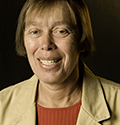
Tatiana Timofeeva
Las Vegas, N.M. – More Highlands University students will have a solid foundation for pursuing doctorate degrees in science and math thanks to a $3.3-million National Science Foundation grant.
The five-year NSF Partnerships for Research and Education in Materials, or PREM, grant is a collaboration with Ohio State University and incorporates chemistry, geology, computer science, and physics. The grant is designed to increase participation of women, minorities and people with disabilities in science, technology, engineering and math fields, collectively known as STEM.
“This is truly a win-win situation,” said Sean Jones, PREM program director for the National Science Foundation. “The collaborations offer unique research and education opportunities for students who likely wouldn’t get this exposure otherwise. You want all the talent you can get. An inclusive investigator pool minimizes research ‘blind spots.’”
Highlands University chemistry professor Tatiana Timofeeva authored the grant and is its principal investigator, or lead researcher.
“The overall purpose of this grant is to bring more students into STEM disciplines and push them to the next step of pursuing a doctorate,” Timofeeva said. “The goal of this research collaboration with Ohio State is to achieve a higher level of understanding of materials design in the areas of electronics, optical and magnetic properties. Our Highlands students will have the chance to conduct exciting cutting-edge research that is at the forefront of materials science.”
Timofeeva, an internationally known chemist who studies the forms and structure of crystals, said materials design involves designing and synthesizing new molecules that can be used for applications ranging from magnetic-based cooling systems for computers to drug-delivery systems that target specific organs.
Crystal engineering research is central to the grant, and some of it will be conducted in Timofeeva’s Crystallography Laboratory.
The grant will fund the research for about 30 science graduate students at Highlands. For their research, the students will use Highlands University’s chemistry, geology and computational science laboratories, as well as laboratories at Ohio State’s Center for Emergent Materials.
The grant also funds undergraduate and graduate summer research internships at Los Alamos National Laboratory in New Mexico and Argonne National Laboratory 28 miles west of Chicago.
One component of the grant involves nanoparticle research in computer science professor Gil Gallegos’ Computational Science Laboratory at Highlands. He is a co-investigator for the grant.
“Nanoparticles are smaller than wavelengths of light, making them the perfect material to control the behavior of light at the atomic level,” Gallegos said. “My students will be building and testing mathematical models of light-matter interaction that will allow them to guide light on the surface of the nanomaterial. Being able to guide light is integral for developing new technologies for computer systems that are faster and more adaptable.”
Highlands geology professors Jennifer Lindline and Michael Petronis are also co-investigators for the grant.
“The cross-disciplinary nature of this research grant will better equip our students to answer complex scientific questions in the real world, as well as allow them to contribute to pushing the envelop in materials science research,” Lindline said. “In my Earth Materials Laboratory we’ll examine the purity and crystal structure of the synthetic materials that are being developed, which is one step in the process of better understanding potential uses of new compounds.”
Another component of the grant is measuring the magnetic properties of the new materials in Petronis’ Paleomagnetic – Rock Magnetic Laboratory.
“In materials design, analyzing magnetic properties helps characterize how metals interact with molecules,” Petronis said. “If materials aren’t magnetic, they wouldn’t be useful for certain applications like an electrical conductor. Collaboration is an important aspect of this grant. It’s valuable for our Highlands students to have the chance to work in laboratory facilities at institutions like Ohio State that grant doctorates.”
As part of the grant, Timofeeva, Gallegos, Lindline and Petronis will develop and teach two upper-division materials science classes at Highlands.
Edward Martínez, a Highlands natural resources management professor who also directs Highlands Achieving in Research, Math and Science, or ARMAS, program, is another co-investigator. He will direct the education/diversity component, including working with the researchers to place undergraduate students in research internships.
“Dr. Martínez and ARMAS will also play an extremely important role in reaching out to students at Robertson High School and West Las Vegas High School to get them interested in studying science at Highlands, beginning at the dual credit college class level,” Timofeeva said.
Other Highlands University faculty who are co-investigators for the grant include chemistry professors Jiao Chen and Qiang Wei. At Ohio State, physics professor Ezekiel Johnston-Halperin is a co-investigator.
In 2009, Timofeeva was also the principal investigator for a $2.7-million NSF Partnerships for Research and Education Materials grant that was awarded to Highlands.
